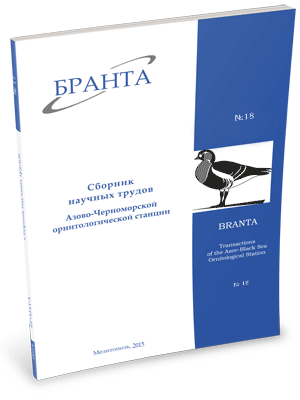
Transactions
of the Azov-Black Sea Ornithological Station



The communities of breeding birds of freshwater and slightly brackish lakes of the Western Crimea.
V. N. Kucherenko, M. V. Banik, A. A. Atemasov, Y. I. Vergeles
The communities of breeding birds of the lakes of the Western Crimea were studied in 2006-2014 by means of counts of adult birds and broods along shoreline sites in late spring to mid summer time. The lakes originated from shallow sea bays or estuaries flooded by seawaters and then separated from the sea by narrow sandbars. Small freshwater wetlands have formed at the easternmost parts of some lakes (e.g. Donuzlav lake) at river or spring inflow points long before the apparent human intrusion. In the 1990s the impact of building new branches of the Northern Crimean canal resulted in heavy influx of fresh water into Western Crimean lakes. The area of freshwater habitats increased dramatically and the communities of breeding birds had become more rich and diverse. 15 species of birds established as regular breeders since the late 1980s. Nowadays the communities of breeding birds of freshwater parts of Western Crimean lakes comprise 30 species (grebes, herons, Mute swan (Cygnus olor) and ducks, Marsh Harrier (Circus aeruginosus), rails, Kingfisher (Alcedo atthis), and passerines). Great Crested Grebe (Podiceps cristatus), Pochard (Aythya ferina) and Coot (Fulica atra) are the dominants, and Pochard apparently dominated among other ducks. Typical but less numerous species of these communities are Little Grebe (Tachybaptus ruficollis), Mute Swan, Mallard (Anas platyrhynchos), Garganey (Anas querquedula), Ferruginous Duck (Aythya nyroca), Water Rail (Rallus aquaticus), and Moorhen (Gallinula chloropus).
Read the paper in a PDF fileReferences:
- Andryushchenko, Yu.A., Atemasov, A.A., Banik, M.V., Beskaravayny, M.M., Vergeles, Yu.I., Kostin, S.Yu., Kucherenko, V.N., ... Prokopenko, S.P. (2013). The Whiteheaded Duck in the Crimea. Kazarka. Bulletin of the Goose, Swan and Duck Study Group of North Eurasia, 16, 70–84. [in Russian].
- Banik, M.V., & Dzhamirzoev, G.S. (2004). On the method of waterbird counts by broods at large bodies of water. Bird counts: approaches, methods, results. Collection of scientific papers of the 2nd international scientific-practical conference. Zhytomyr. [in Russian]
- Beskaravayny, M.M. (1999). Fauna and bird communities of breeding hydrophilous birds of freshwater habitats in the South-Eastern Crimea. Problems of studying fauna in South Ukraine. Collection of scientific papers. Odessa: “AstroPrint” Print, Melitopol: Branta. [in Russian]
- Beskaravayny, M.M. (2007). Towards southern borders of distribution of some elements of breeding ornithofauna of the plains and foothills of the Crimea. Branta: Transactions of the Azov-Black Sea Ornithological Station, 10, 7–27. [In Russian]
- Beskaravayny, M.M. (2010). Toward more precise determination of borders of distribution of some ornithofauna breeding species in the Crimea. Branta: Transactions of the Azov-Black Sea Ornithological Station, 13, 76-80. [In Russian]
- Beskaravayny, M. M., & Spivakov, O. B. (1993). Breeding of the Black-necked Grebe in the Crimea. Vestnik Zoologii (“Zoological Herald” Journal), (4), 77. [in Russian]
- Vergeles, Y. I., Banik, M. V., Kucherenko, V. N., Atemasov, A. A., & Goncharov, G. L. (2012). Breeding ofthe White-headed Duck in Western Crimea. Kazarka, 15(1), 145–149. [in Russian]
- Voinstvensky, M.A. (2006). Diaries of the Crimean expeditions of 1957 and 1958. Avifauna of Ukraine, (3), 2-40. [in Russian]
- Grinchenko, A.B. (2009). Changes in breeding avifauna of Anseriformes in the Crimea connected with anthropogenic succession of Sivash and steppe part of the peninsula. Branta: Transactions of the Azov-Black Sea Ornithological Station, 12, 59-70. [in Russian].
- Gulov, O.A. (2008). Ecocide of Crimean salt lakes (up-to-date geoecological review with elements of economy). Ekomir, 1 (9), 3-10. [in Russian]
- Dzens-Litovsky, A.I. (1962). Salt lakes of the Azov-Black Sea coast and Steppe Crimea. Transactions of the scientific-research institute of salt industry, 4 (12), 16-70. [in Russian]
- Kostin, Y. V. (1983). Birds of the Crimea. Moscow: Nauka” Press. [in Russian]
- Kostin, S.Yu., & Tarina, N.A. (2004). Distribution and biology of Pelecaniformes and Ciconiiformes on the Lebyazhy Islands and surrounding area. Branta: Transactions of the Azov-Black Sea Ornithological Station, 7, 82-111. [in Russian].
- Krivitsky, I.A., Kozakov, G.S., & Reva, P.P. (1999). Birds of Lake Donuzlav. Problems of studying fauna in South Ukraine. Collection of scientifi c papers. Odessa: “AstroPrint” Press, Melitopol: Branta. [in Russian]
- Molchanov, L.A. (1906). Bird list of Natural History Museum of Tavricheskoye Gubernskoe Zemstvo (Tavria Province), Simferopol. Materials on studying fauna and flora of the Russian Empire. Department of Zoology, (7), 248-301. [in Russian].
- Nikolsky, A. M. (1891). Vertebrate animals of the Crimea (Vol. 19). Saint Petersburg. (Notes of the Academy of Sciences. – Volume 68. – Annex 4) [in Russian]
- Oliferov, A.N., & Timchenko, Z.V. (2005). Rivers and lakes of the Crimea. Simferopol: “Dolia” Press. [in Russian]
- Podgorodetsky, P.D. (1988). Crimea: Nature. Simferopol: Tavria. [in Russian]
- Popenko, V.M., & Diadicheva, E.A. (1999). Distribution and numbers of breeding passerines of reedbed complex at Sivash. Fauna, ecology and protection of birds of the Azov-Black Sea Region, 27-29. [in Russian]
- Order of the Cabinet of Ministers of Ukraine of 11.12.1996 No 1449 “On the approval of the list of water objects relating to the sanative category” [in Ukrainian]
- Puzanov, I.I. (1960). Over the untrodden paths of the Crimea. Moscow: State Press of Geographical literature. [in Russian]
- Sokolov, A.A. (1964). Hydrography of the USSR: land waters. Leningrad: Hydrometeorological Press. [in Russian]
- Tarina, N.A., & Kostin, S.Yu. (2011). Annotated bird list of “Lebyazhy Islands”, a branch of the Crimean Natural Reserve. Scientific notes of the Natural Reserve “Mys Martyan”, ( 2), 177-215 [in Russian]
- Siokhin, V. D. (Ed.). (2000). Numbers and distribution of breeding waterbirds in the wetlands of the Azov- Black Sea Region of Ukraine. Kyiv. [in Russian]
- Pusanow, I.(1933). Versuch einer Revision der Taurischen Ornis. Bull. of Moscow Nat. Soc., 42 (1), 3-4. [in German]